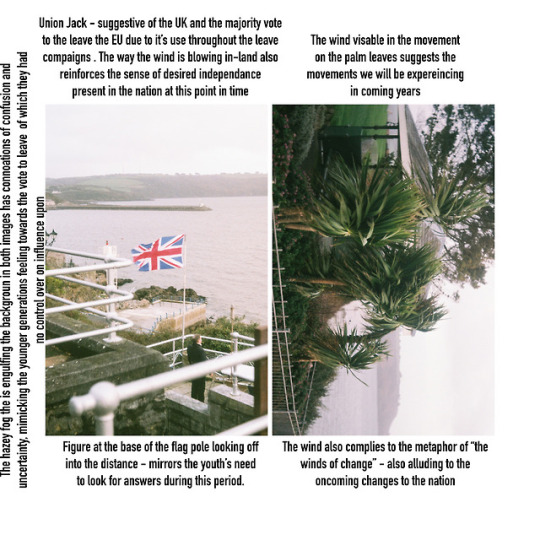Link
0 notes
Text
Interview with William McCleland
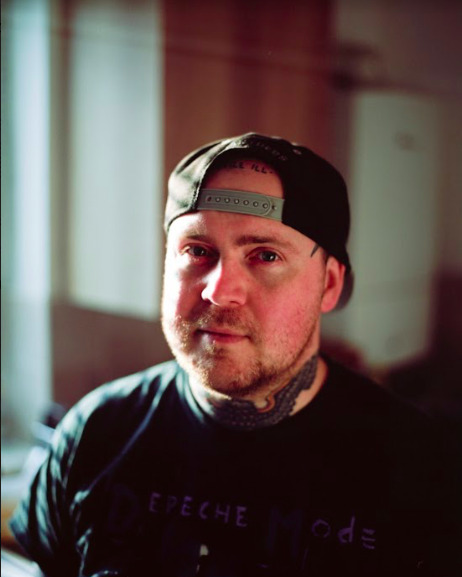
William McCleland is a portrait and contemporary landscape photographer who mainly produces work with the use of medium format analogue cameras, following the completion of his BA Honours degree he is current living and working in his hometown of Brighton as freelance practitioner.
I personally discovered William’s work whilst visiting the “The Sea and Me” exhibition at Plymouth Arts Center in 2016. At this point in his career he was predominantly working with landscape photography however has shifted his focus to portraiture over recent years. I has initially chosen to reach out to this photographer as he has had influence on a variation of my personal work as well as that I have used in response to recent modules. His work and use of analogue cameras was one of the things that had inspired me to make the change from digital to analogue and I am thankful that it did. I admire his conceptual ideas, aesthetic and versatility and am looking forward to discovering more in regards of his practice.
William’s work:
http://willmccleland.co.uk
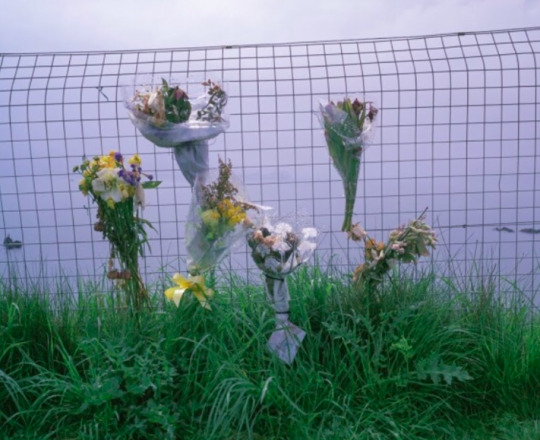
Interview
Just to start off with, what do you love about photography?
I really enjoying having the ability to portray a certain message through an image and spread your thoughts, feelings and opinions to others without necessarily having to physically say anything.
What initially attracted you to photographic practice?
So as many did, I began studying art at a GCSE level and then found my way to photography through my experimentation in this period. I started out with hopes of becoming a illustrator or painter as that is what I had been doing from a young age however once I’d started working with different cameras and understanding the power of imagery I was hooked!
Do you feel there was a point of influence in your life or is artistic practice just something you found interest in on your own?
There definitely was a point of influence in my opinion. I spent a lot of time with my grandparent when I was very young who were both quite “arty”, especially my nan. She use to create paintings in the styles of Picasso and Van Gogh, filling sketchbook after sketchbook of these incredible pieces that she never really did much with. I feel that the aesthetic found within her work still resonates in my own to an extent and that’s something I am going to always work to keep up.
Other than this influence, are there any theme you consistently look to portray within your work?
I wouldn’t say so, no. I try to keep my work fresh and not linger on the same style of ideas for too long unless it for a purpose, such as for an exhibition of photobook. I suppose that I have completely a few bodies of work that look into the experiences people indur within their teen/young adult years and those of people who are facing uncertain times. Visually, I like to think that there are consistencies but no so much within my conceptual work.
Is there anything you do to prepare for shoot?
Prior to shooting any portraiture I always make the effort to get to know the person/people I am working with just because it makes the whole experience for more relaxed and comfortable for them and myself. I feel it’s important to know your subject well to be able to show them in the right light. In regards of still life and portraiture, I just plan what I want to shoot and use that as a goal.
On your website, you specify that you work almost explicitly on medium format? Is there a reason for this?
Working on medium format is something I picked up during my time spent at Plymouth Uni after being told it would take my work to the “next level” by a lecturer. I feel it really does seperate my recent work from that I completed a few years ago as it has benefited my composition as well as my aesthetic approach. Not only this but I do also really enjoy it, it’s definitely a personal favourite.
I keep up with your work avidly on social media and it seems your following has grown massively in the few couple of months, are there any tips you have for extending your audience?
Thanks for noticing! I’ve been entering a lot of competitions and exhibitions lately and that has definitely helped me out loads. I’ve recently had an image from my Out of Step series shortlisted for the Palm Studios photo prize which has given me an influx of supporters, it’s been amazing seeing my work on platforms like this one. So yeah, pushing you work and getting it out there always helps. As well as this it is always good to get involved in local art-based communities and getting your name recognised by those in your area to start off with.
Finally, any last pieces of advice for budding photographers?
For sure, in my opinion is a massive advantage to have defined your own aesthetic as opposed to working with what’s popular at the time as it separates you from the bunch. Be as artist for yourself, there’s no need to become a carbon copy of which ever work inspires you. Of course take influence but it is really important to find your feet in the industry.
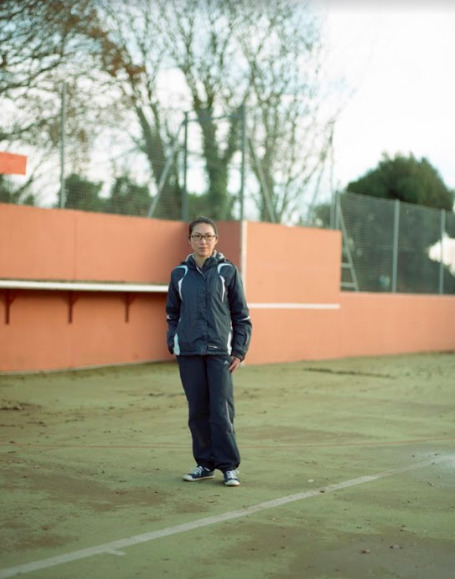
Reflection:
I found this experience to be really interesting and insightful. From this I will take away the motivation to push my work further into the artistic community, making use of the ways shown in this interview. I enjoyed this opportunity and am thankful for the time William spent on this, having built this bridge of communication being the two of us it may come in beneficial to my practice in future.

0 notes
Text
Andreas Gursky at the Hayward Gallery, Southbank Centre
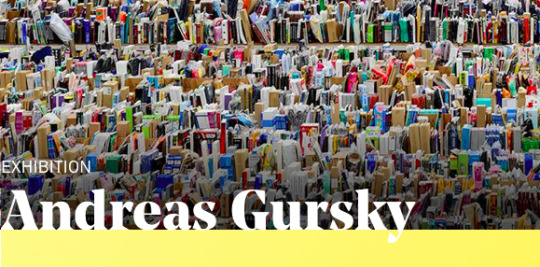
This exhibition is the first large scale showing of this artist’s work in the United Kingdom. German photographer Andreas Gursky has become recognisable for his awe-inspiring imagery, large scale exhibiting prints and his reflection upon the iconic scenes evident with the global economy and consumer ways life. Gursky has understandably gained the title of one of the most significant and influential photographic artists of our era.
With the use of the imagery Gursky has produced throughout the last four decades, this exhibition explores every aspect of his incredible career within the artist world. The versatile work depicts vast landscapes, bustling crowds and artificial structures of unbelievable size. The exhibition is definitely one to leave audiences in a state of amazement through the combination of shear size and great precision, each image in the collection is present in such a size it always viewer to almost fall into it. Making the viewer feel detached from the outside world for the time in which they’re observing the work.
Taking motivation from his own interests and thoughts of the ways our modern lives work and correlate with one another, Gursky creates imagery that reflect the barriers of human acknowledgment. He usually photographs from extremely high vantage points to produce a perspective that many are no accustomed to it causes what it perceived as an almost democratic view, leaving all aspects equal.
The Hayward Gallery presents around 60 of Andreas Gursky’s most iconic photographs, dated from the 1980’s up to current day. One image I was most looking forward to seeing in the exhibition was Rhine II (1999, remastered in 2015) due to controversy that surrounds the piece, the price of which it recently sold for and to witness it in person which will either reinforce my own opinion of the piece or prove me to be incorrect. This exhibition also marks the Hayward Gallery’s 50th anniversary year, giving it an even higher significance in the nation’s artistic calendar.
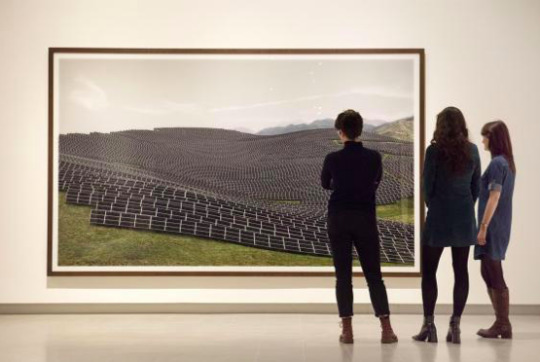
My Reflection:
I found it astonishing how every aspect of the imagery was in focus and how every detail is visible with the exhibited prints. It was fascinating, I and many other spent a rather long period of time examining every inch of the images as new features would be evident on the prints where they perhaps were unidentifiable when observing the images online. The way in which the images was present was monumental alone but when combined with the work in which was frame it was extended to a new level. The images were evenly spaces amongst the gallery walls, all of a relatively consistent size and with titles/artist statements in the same position alongside each piece. I found this level of precision made the exhibition that slight part more impressive and gave it a sense of awe that matched that of the images. The only criticism I formed in response to the presentation was the variation of frames used as there was a range of white, black and wood-tone used in no particular order. This didn’t act as a major distraction however if they would have all been the same style then I would have had no negative points to state.
0 notes
Text
Work Experience Diary
For my one-day work experience I worked alongside and assisted photographer William McCleland on a recently commissioned shoot. I initially enquired about this opportunity in my recent meeting with him in which also conducted my interview. As he usually works in Brighton and was only in Plymouth from a limited time before returning home I decided to see if I could make the most of this time. He agreed to allow me assist him during the shoot and we went forward to make arrangement and conduct the shoot. This shoot took place in Plymouth on the 12th of May. As I had recently conducted an interview with Will which allowed me to explore his practice, I was looking forward to this day greatly as I would have the chance to see how a practicing photographer ran a shoot.
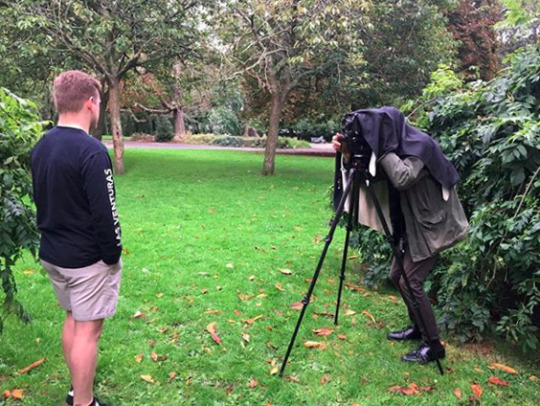
Brief Diary of the Day:
9:30am / Meet with Will and look over the plans for the day. During this time he has assigned me certain roles for the day such as taking light metre reading, positioning any lighting/reflectors if needed and assisting in the developing of the film later in the day.
9:45am / Meet with client and re-confirm plans with them, making any necessary changes they suggest.
10:15am / Travel to and shoot at the first location (Beaumont Park).
10:50am / Travel to and shoot at the second location (Plymouth University’s natural light studio). As Will is a Plymouth University alumni and over his years of study built a good relationship with the lecturer they allow him to use their studios from time to time. Will stated this is a great attribute to his work and has attracted a handful of clients recently.
11:30am / Travel to and shoot at the third and final location (the client’s home).
12:00pm / Finish shooting and break for lunch.
12:45pm / Travel to Will’s temporary developing space that he had constructed at a friend’s home.
13:00 - 14:30 / Developing the film that we shot throughout the day
15:00 / Complete and reflected on the day and received feedback from Will.
Reflection on My Experience:
I found the time spent with Will to be very beneficial and thoroughly enjoy, it was really interesting to see how an artistic practitioner conducts business when working with a client and how they have precise plans for their days to ensure everything was completed in line with the clients expectations. Throughout the day I work as I was instructed and gave shooting suggestions where I felt they were necessary, Will was welcoming of these suggestions and allowed me to be heavily involved in the shoot which exceeds my expectations. As we had initially planned, I took light metre reading and assisted any lighting needs primarily during the day. I also made any relevant adjustments to the locations such as clearing obstructions and loaded the camera on some occasions. Being involved to this level gave me a realistic idea of the processes involved in the practice, I would’ve liked to see the planning and communication between Will and the client to get an idea of the preliminary actions that take place prior to the shoot.
During the development of the film shot on the day I mostly just observed as I don’t have a great deal experience working with colour medium and large format in the processing room. Watching Will work allowed me to gain some great insights to the process and techniques used and has given my inspiration to attempt creating my own colour processing space at home, perhaps over the summer holidays.
Feedback I Received:
“You worked faultlessly throughout the day and I would enjoy collaborating with you at a more professional level at some point in the future. To enhance your personal practise I would suggest gaining a good degree of processing and darkroom experience to ensure she has the relative skills to produce your imagery as an individual and, as identified within our interview, boost your online presences so that your work is able to reach a wider audience. This will hopefully in hand bring custom, given you’re is at the stage in her career that you are ready to take on work. Thank you for all the help and I look forward to working with you!”
0 notes
Link
0 notes
Text
Proposal
“Brexit”
For my response to the short project titled Economy I will be exploring the consensus of the youth’s stance regarding the results of the recent Brexit vote. In the recent referendum our nation voted to leave the European Union and we are currently in somewhat a state of uncertainty, with our Prime Minister falling through on the majority of her own manifesto and making seemingly panic-influenced choices in regard of the next steps of Brexit. At the time of the Brexit vote I was unable to partake due to being under the age of eighteen, similarly to many of those who are now raising concerns. I feel that the majority of my generation were left in the dark in this period despite being mearing months away from being legally able to vote. With Brexit now being a reality I am quite concerned with what the coming years will bring and how it will effect my life as my generation will be the first to experience the new post-Brexit “adult” world. I believe that I will be working with contemporary landscape and social documentary for the most part of the project however I may experiment with portraiture and other areas of photographer if I feel it is suited to my project.
Throughout this project I will be conducting a range of explorations to decipher to general tone regarding this amongst my age group to ensure I portray a realistic vision of the response, I will also be looking into a range of artist that will benefit my produced work. At this point in the project I am planning on working exclusively on 35mm as I am comfortable with the format and I feel that I will be able to produce a suitable body of work with the use of it. As this project is solely leading up to the Economy exhibition I will bare this in mind throughout, consistently reflecting on my own work and how I would translate this into the exhibition space.
0 notes
Photo

Research
Mark Power
Magnum photographer, Mark Power, has played part in multiple solo and group exhibitions throughout his career in the visual arts. Initially Power graduated Brighton Polytechnic with a 1st degree in Visual Communications, specialising in painting and illustration. Following his graduation he travelled South East Asia and Australia for two years and during this time Power discovered his love for photographer was overpowering that of his previous artistic focus, prompting him to become a photographer upon his return to England once he had finished his travels. In the subsequent years of his life he work for range of charity and commercial purposes before beginning his teaching career in 1992. Alongside Powers years of teaching he also embarked on a multitude of self initiated projects of which now rest alongside his back catalogue of large-scale bodies of work.
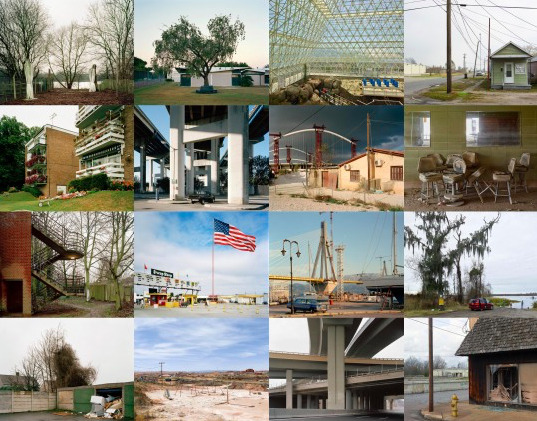
In regards of his personal work, I personally favour those titled 26 Different Endings (2003 - 2006), CaCO3 (2006), America AZ/UT/NV (2017) and Black Country Stories (2011). Throughout Power’s work I feel that there is a set deadpan aesthetic that has resonated across his career. As well as this I feel that his work is very compositionally strong due to his use of shape, line and perspective. I feel that this photographer’s use of composition to enhance the imagery is most evident in his body of work Periplus (2004). For the duration of this project, Power focused on man-made concrete infrastructures located in Greece in the months leading up to the Olympic Games. This focus on architectural structures enabled Power to capture strong linear formations against muted, monochromatic backgrounds - in hand creating a high contrast that has caused a smooth divide between the featured elements. The lines evident in the imagery allow the viewers eye to explore the image with ease and gives the image a boost of interest.
The image was taken by Power in Wisconsin, Midwestern USA during his work with the resonating titles of Postcard from America, with this becoming the fifth instalment in the April of 2014. This project showcases many locations around the state of which all have strong compositional lines presents and an appealing variation of corresponding colour pallets, primarily depicting exterior spaces.
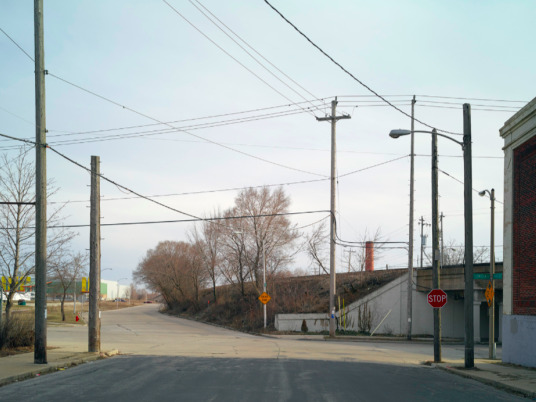
I have chosen to look into the image shown above as I was drawn to it amongst the rest. I feel that it coincides well with my own and many other’s perception of what Wisconsin would be like and this is due to the muted colours of the sky space and lack of activity in the foreground. Personally, I believe that Wisconsin is a rather quite place in comparison to others around the U.S.A and this is because of it’s minimal appearance in global news. In comparison to state such a California that draws a great deal of media attention, Wisconsin is considerably less known. The flat greys and blue tones present in the sky are suggestive of dullness, modesty and deficiency of emotion. This is due to the low number of points of interest for the viewer to focus on, in hand leaving an empty space in their interpretation of the image. In regards of the composition of the piece I believe it is enhance by the use of line throughout the photograph. The lines present in this image direct the viewers eye throughout the piece with ease and create a structure within the photograph. The slight curvature of the road that moves through the lower sections of the image breaks up the formality of the lines and produces more of a natural visual journey. Another compositional factor of this image that I feel Power has used to his artistic advantage is the rule of thirds. When the grid is applied it appears that the majority of the foreground and ground moving towards that back of the image, creating a realistic pathway within the image. The mid-section showcases a variety of vertical lines of which act as a great transition between the lower and higher sections of the piece and finally the higher third produces a contrast between that and the lower third due to this lower being visually full and the higher having a more minimalistic tone.
Josef Sudek
With the means of finding alternative ways to portray my conceptual response to this project brief I have chosen to look into the workings of Josef Sudek and more specifically his sequence of photographs titled “The Window of My Studio”. I feel that this body of work signifies the sense of safety and sanctity felt when amongst his belongings and surrounded by familiar views. From this I could take the ideas of the importance of objects and environment and combine those with my aims of photographing contemporary landscape to show the thoughts and feelings of the younger generation to the leave vote.

Sudek originally served in the armed forces prior to getting discharged due to injury, following his discharge he had taken up bookbinding and his interest in becoming a photographer grew from there. Based solely in Prague, Sudek produced imagery of which depicted neo-romantic cityscapes, still life and pristinely composed “point of view” images - all almost always void of any persons. The production of the series titled “The Window of My Studio” spanned over the majority of his career. He embarked on this project due his admiration of how his widow refracted and distorted the light of which came through it. Due to the time of which Sudek was actively contributing to this project i believe it to be an ode to the safety he felt in his space and it provided solitude amongst the uncertain and war-torn world that laid outside.
Wirgin Edixa Flex
The Wirgin Edixa Flex is a camera I have been using for close to a year now and has to come to be one of my favourite 35mm SLRs. I find it to be a very straight forward camera to use and I am comfortable using it in a variety of situations. It is a fully manual camera with no automatic setting present at all, this means that you are need to either use a light metre prior to taking an image or estimate the settings using the “sunny 16” rules. Located around the body and lens on the camera are the setting controls for the shutter speed and aperture. You don’t need to manually set the ASA of the film on the camera but you will need to bare it in mind when exposing.
The Camera:
Diagrams taken from the Wirgin Edixa Flex user’s manual

Composition
The Rule of Thirds
Use of the rule of thirds can make images appear more interesting than they potentially would be if they were composed with no influence having been taken from this rule. Positioning subjects along these guidelines and intersections enables the viewer's eye to explore the image with ease and creates a greater sense of balance within the piece.
The Rule of Thirds includes applying imaginary horizontal and vertical lines to the framing of an image. During the compositional stages of an image, working to coincide with this rule would involve placing the major planes or focus areas on these lines. For example horizons would fall onto the horizontal lines and building/trees would fall onto the vertical lines.
The crossover sections of these lines are suggestive of where the centre of interest would compositionally benefit from the placement. The placement selected by the artist is dependant on the subject and how they desire the subject to be presented to the viewers.
Line
Line can be used within visual art to direct the viewer’s eye through the piece. The use of line enables the ability to communicate what we see. Compositionally line can be used horizontally or vertically in either straight or curved format. When used straight in an image it creates a very direct and closed direction, giving little opportunity for lead exploration. To oppose this, a curved line opens up the image as the curvature diminishes any abrupt edges and creates a larger open area.
Line can also be caused by shape, form and contrast and despite this being dependant on other factors of image it is still controllable.
Perspective
Linear Perspective:
With the use of linear perspective distant objects appears proportionately smaller than those of which are in the foreground
Atmospheric / Aerial Perspective:
This term describes the effect on the appearance of an object caused by the atmosphere separating it from the viewer.
Overlapping
The overlapping of objects within a frame can be suggestive of space and atmosphere. Through the use of this compositional technique the artist can rid the image of flatness, in hand allowing the viewer to visually travel through the image. This application of layers within a piece creates a sense of dimension and depth which I believe had the ability to enhance imagery greatly.
Filling Frame
I don’t feel that filling the frame is an important factor to consider when deciding on the composition of an image as I believe it depends on what you’re trying to achieve with the piece. Filling the frame allows you focus in on one or multiple areas of an image that may go unnoticed in the frame was wider. It works well if you are wanting the audience to view a specific detail of the piece.
Revisiting Aperture, Shutter Speed and ASA
Aperture:
Aperture is measured in ‘f stops’ and is used to regulate the amount light that contacts the sensor. The higher the aperture the more light gets in, the lower the aperture the less light gets in - for example f/2.8 = large aperture (high level of light) and f/22 = small aperture (low level of light). Moving from one f-stop to the next either doubles or halves the size of the opening, therefore doubling or halving the amount of light that is able to reach the sensor.
Aperture is a very useful tool when it comes to controlling the depth of field present in an image. Depth of field refers to how much of a shot is in focus. A large depth of field ensures that majority of the subjects/objects in an image will be in focus whereas a shallow depth of field only allows a small percentage of the image to be in focus. To achieve the shallowest depth of field possible on you have to shoot in f/1.8 or an aperture setting similar. As a large depth of field is an direct opposite to a shallow depth of field as are the settings; to achieve a large depth of field you have to shoot in f/22 or another small aperture setting.
A small aperture is useful when shooting landscapes, architecture or macro photography whereas a large aperture is useful when shooting portraits.
Shutter Speed:
The shutter speed refers to the length of the period of time the shutter is left open for. Personally I think shutter speed is easier to understand than aperture due to the fact it is measured in fractions of a second. The use of fast shutter speeds enable you to freeze motion and capture sharp, focused imagery despite any unsteadiness or how fast the subject is moving. The slower the shutter speed is the greater the chance of motion blur, this may be a bad thing at times but can also be used for creative purposes.
Aperture and shutter speed work together to create an exposure. For example a small aperture requires a slower shutter speed to ensure the right amount of light is absorbed by the sensor so that the image isn’t over or underexposed. If you’re working in Aperture or Shutter Speed Priority the combination will be worked out for you, however if you are working in Manual it will not.
If in the circumstances where you chose to or are required to shoot without a tripod you will need to have a fast enough shutter speed to ensure that there is no camera shake or blur in the shots. A good rule to follow is to use a shutter speed that is faster than the focal length of your lens. For example if you were using a 200mm lens you would be working in 1/250 or similar.
ASA:
The term ASA is used in reference to the available light and the level of sensitivity present in your camera. Simply, the lower the ASA then the less sensitive the camera will be to light and in opposition the higher the ASA then the higher level of sensitivity. The specific piece of technology within your camera that is affected by this in the sensor, this component is responsible for collecting light and translating it into a photograph.
A high ASA would be useful in the case of shooting in a circumstance with low levels of available light, unfortunately when using a high ASA it causes the image to become noisey and show visible gain which may not always benefit the image however if this is the aesthetic that you are striving for then it works well. At the opposite end of the ISO scale, at a low ASA, the imagery created would appear very clear and well depicted the higher image quality.
0 notes
Text
Photographic Response to “Economy”
I had initially planned to shoot with the purpose of using the work from this assignment however in review of some recently developed film, I found that I had a set of image that I felt coincided with my conceptual focus well. For the shoot I had previous stated how I was to look at shooting on 35mm which these images are so they are still relevant to my proposal. In my mind I had given some further thought to the shoot in regards of potential locations and the imagery I was to aim to capture. I was certain the shoot would take place in Plymouth across a handful of locations such as The Hoe, the lower end of town, the markets and their surrounding areas due to the level of British iconography found within those areas and their juxtapositioning amongst less visually appealing spaces. I had the idea of focusing on Union Jack flags as it has recently become associated with those who voted to leave the EU and the celebration of the UK as an independent body. As well as this, as I had identified that many of my generation are feeling uncertain/concerned regarding what will be happening post-Brexit I was to also attempt to portray these feeling through my work. Despite having not specifically shot in accordance to this plan I do still feel that the images correlate with these aims well.

0 notes
Text
Post Production
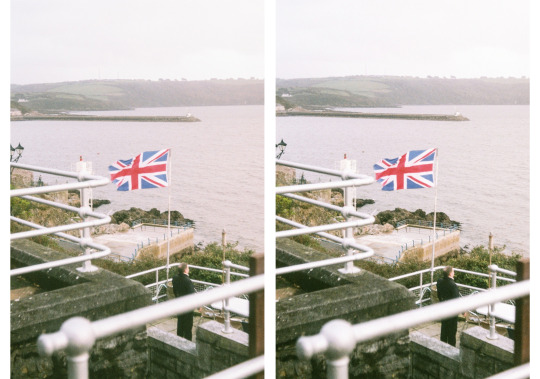
Unedited image on the left. Edited on the right
Moving through this stage of the work, I was attempting to keep the post production to a minimum as it’s not something I felt would benefit the images greatly if I had produced multiple layers. I was purely aiming to perfect the tones in the image and make any necessary compositional enhancements. Once open in photoshop I chose to lower the red hues that were present in the background of the image, raise the clarity and contrast to give the piece a more dynamic appearance, lowered the black point to reinforce the level of contrast and tilted the piece the left slightly to ensure the horizon and lines in the foreground we’re straight.
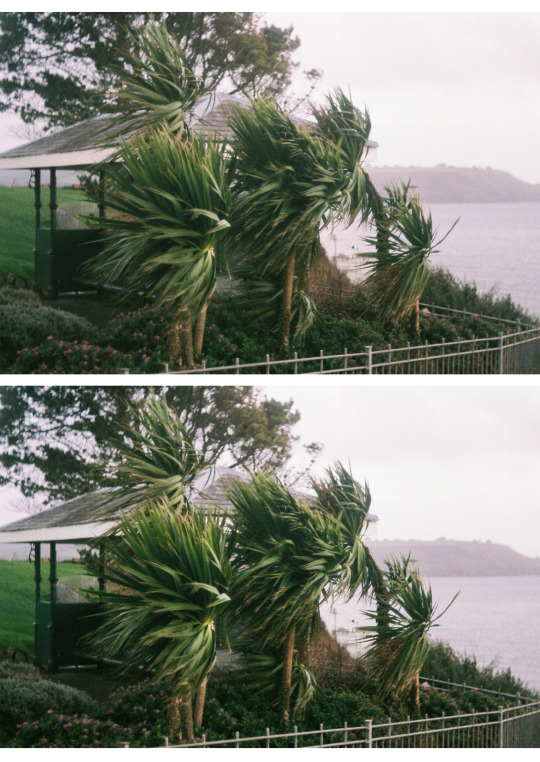
Unedited image on the top, edited is beneath.
Similarly to my approach to the editing of the first image, the main aim was to do minimal work on the piece. Once again I lowered the red hued in the background of the piece, raised to clarity and contrast, raised the saturation of the palm leaves and boosted the levels of the highlights. I feel these editing choices did enhance the overall image but has allowed me to keep the original connotations within the piece.
0 notes
Text
Production Review
Despite having not specifically shot for this project, I feel that the images I have selected and that I will be progressing with are fit for this conceptual project and represent my work well. I am happy with the images and look forward to presenting them in an exhibition environment. Within the images I have used a range of factors to portray my desired message of the negative effect the Brexit vote has had on the youth of today, the pieces are suggestive of the leave campaign and the general youth general reaction to the nations choice to leave.
The images were shot using my Wirgin Edixa Flex, a 35mm SLR that I use quite regularly for both personal and university work. I shot using Kodak ColourPlus ASA200 as it is a personal preference of mine and I feel it captures muted tones, such as the ones evident in fog and mist, really well. As the image was taken during daylight hours I had no issues using the film speed and it proved to be beneficial to my work. I feel if I were to reshoot the chosen images I would take more time composing them and ensure that more details were in focus, perhaps making use of a smaller aperture.
0 notes
Text
Exhibition Plan
For my photographic input to the exhibition I will be showcasing my two previously selected images as I feel that they connect to the overall Economy brief as well as my self initiated conceptual idea. After observing the size of the exhibition board i have planned to print both image 8x12, with one being shown in portrait format and the other in landscape. As well as this I will be making use of a name card and an artist statement to accompany my work in the exhibition.
Below is a depiction of how I am hoping to exhibit my work:
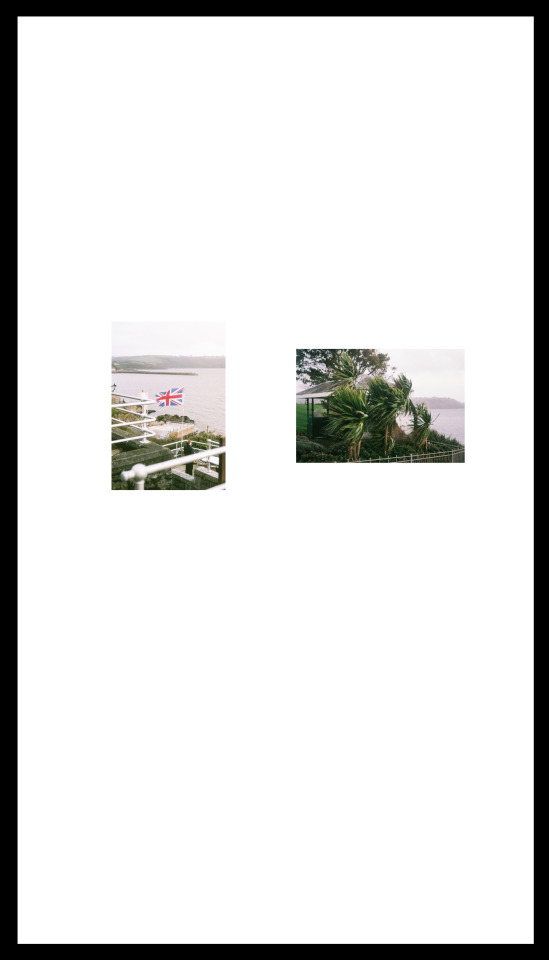
I have chosen to present them in this format just as I feel that they look best in this order. I wasn’t influence by any aspect of the image to do so as there is a limited amount of linear presence in the imagery that could have been used to ease the visual exploration of the images for the audience. I have placed the image in the central space on the board as this placement will be consistent throughout the exhibition, as discussed with other members of the cohort. At this moment in time I am not aware of the type font or size of the names/artist statements so I have not included it within this plan however I will featuring them on my exhibition board.
0 notes
Text
Involvement in the Exhibition Preparation
Due to my absence throughout this module, caused by an array of personal issues that came up throughout, I had missed the initial session in which we were placed into groups and I was unaware of any group work taking place until a handful of days before the exhibition was due to take place. By this point, the groups were already formed with they’re work complete so I was left out of the picture but I feel I worked to make up where I could. I understand that it was partially my responsibility to reach out get involved with this group process but as there was no sign of this on Google Classrooms nor the class’ group chat I was unaware it had taken place to start with. If I would have the opportunity to go back and change this I would be unfortunately this is not a possibility.
Areas I had worked in:
Painting boards and clearing the space prior to the exhibition
Sharing and inviting people through the use of social media. This involved sharing/inviting directly from the Facebook event page as well as posting from my personal accounts, promotional organisational pages (linked with Ocean City Hardcore) and my photography accounts.
Giving the £10 contribution to the exhibition team for purchase of refreshments, paint and painting equipment, flyers and posters.
Having my work prepared in time to ensure that no plans were hindered by my lateness.
Hosting the exhibition during my allotted time frame and giving relevant information to any attendees who observed the exhibition during this time.
Painting and Preparing the Space:
This stage involved clearing the exhibition space of any unnecessary items such as chairs and small clutter, painting the boards to ensure that there were no visible flaws on them, erecting the boards once dry and cleaning paint marks from the floors. This was done over the days in which were leading up to the opening of the exhibition and were mostly done as part of a team to ensure that this process was completed swifty and to a high consistently high standard.
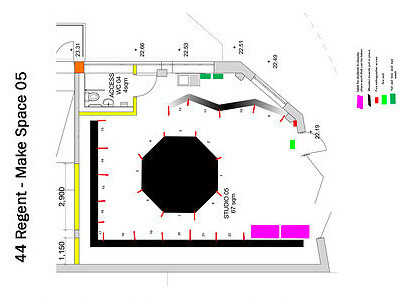
We were working in accordance to this floor plan (shown above) which enabled the process the flow with ease and gave the group a sense of direction even when working individually
Promoting the Exhibition:
As I work as part of a promotional company I chose to use my social media outlets and contacts to push this event. In the days leading up to the event I ensure that I shared the event page daily to draw attention to it and attract more possible attendees. I shared the event across multiple social media platforms on a range of accounts in an attempt to reach as wide an audience as possible. I also gave some advice to those who were posting posters for the event around the city centre, as this is something I do regularly I had the knowledge of which place you are and aren’t allowed to poster, equipment to use to ensure the poster stay up and which times are best to do it to avoid any issue.
£10 Contribution:
I gave the necessary £10 contribution to one of the groups as everybody else in the class had, I wasn’t specifically made aware of what this was going towards when I was first asked but was eventually told. Due to having to wait for money to enter my bank account I was slightly late giving this to the relevant team with no problem.
My Work and Hosting Slot:
As required, I had my work printed and prepared to be mounted on the wall for the stated time. This allowed myself and the rest of the group to meet out set deadlines and stay on schedule. During my allotted hosting time I had the relevant information of each artist at hand if it was asked for by any viewers who would’ve wanted some more information, this information consisted on the names of their photography base social media such as Instagram and Facebook page accounts.
0 notes
Text
Exhibition Review
My Work:
In my opinion my work was presented on the exhibition boards very well, despite having to used tape to mount the images on the wall as opposed to my pre-planned preference. I wasn’t overly happy with my submission to the exhibition to not having my name or artist statement printed to display alongside my work. This meant that my work was the only one in the exhibition that did not have this and I’m not sure as to why those who took control of producing these features did not print my, despite it being placed within the relevant group file by the time they had specified. Other than this I am content with my photographic contribution, as specified in my involvement reflection there were aspects I could have imporved in that specific area however I am happy with what I produced.
The Overall Exhibition:
In reflection I feel that the exhibition went very well, when bearing in mind that this is the first that we have conducted as a group. The space looked professionally produced to a degree and did attract a good amount of people throughout the time it was open. There were some aspects that I felt could have been improved upon however these observations have marked a clear path for how to conduct a better exhibition in future.
The highlight of the exhibition was the presentation of the imagery was great, the image quality was consistent and they were all shown in similar formats. We had used rope and sellotape to create temporary guidelines to ensure that the work was hung at a constant level which in hand gave the exhibition a sense of continuity despite the concept of the work varying.
As alluded to above, there were areas that I felt could have been better. These areas consisted of the the appearance of the artist names and statements, opening times, hosting times and appearance of the exhibition boards. The artists names and statements were, in most cases, bigger than the work it was accompanying. I’m not sure who was in control of this feature of the exhibition of whether there was an issue with printing or not but I do believe that the shear size of them lowered the level of professional appearance. I had multiple people make me aware that the opening times weren’t suitable for those who wanted to attend the exhibition but worked during the day but to my knowledge this was uncontrollable due the space we made use of. Personally, I feel that the hosting times were poorly constructed as when I arrived to complete my slot there were five other student in the space who were also hosting. I felt that this number of people was unnecessary in comparison to the size of the space and the fact that the hosting time slots only lasted for 30 minutes. During the exhibition I had observed a number of faults and inconsistency in the painting we had completed on the boards. Many were done really well however others were not - with multiple dirt marks, screws and gum tape being visible on them. As stated above, I feel that these imperfections have shown us as a group what needs to be done to avoid this in future
0 notes
Text
Overall Evaluation
Reflecting upon the duration of this module, I didn’t feel that it was my favourite of the year nor the worse. I feel this is because of my absence and not feeling that I had made the most of the module and the opportunities that were available throughout. There were areas I really enjoyed such as conducting the interview and work experience but in hand there were those that I did not enjoy such as the preparation for the exhibition. There are a handful of things of which I could’ve improved upon throughout the past months however I am happy with the work I have produced in response to the brief and the experiences I have gained. I felt the brief itself was very straightforward and easily understandable, it allowed a lot of space for artistic interpretation in regards of the Economy division of the brief and freedom of choice when deciding who to interview and complete the day long work experience with.
I thoroughly enjoyed conducting the interview and work experience for this module. I completed both of these areas with assistance from freelance photographer William McCleland, having initially met him during the interview I enquired about the possibility of working with him for experience to which he was happy for me to do. The interview primarily focused around his points of influence for his work and his background, this enabled me to gain a deeper insight into his practice that I previously haven’t been able to gauge purely from his social media outlets and his website. I found it really interesting that their were some comparisons between Will and I in this retrospect. He also advised on ways to promote work to a wider audience and raise it to a higher level which I definitely be revisiting and working with in the coming weeks in an attempt to better my level of professionally. During my work experience with Will I spent time working as assistance to a commissioned shoot he was conducting during his brief time in Plymouth. Within this time I did basic tasks such as taking light metre reading, controlling and manipulating lighting when necessary, clear the composed frame of any obstruction and just generally helping out when and where-ever I could. I also made a handful of suggestion in regards of use of location, posing of the subject, composition and lighting. Following the time spent shoot I was allowed to observe Will work to process the film of the day which enabled me to pick up some great techniques for the development of medium and large format colour film. Looking back on the day, I really enjoyed the time spent with Will and am thankful that I had the opportunity to work with him even at a relatively basic level. He gave me some great feedback on my own work and how I was during the day which I have taken on board and will be bearing in mind over the coming weeks. He also invited me to collaborate with him over summer which I am looking forward to greatly.
Moving onto the Economy brief and exhibition which was what i felt to be the worst part of my project. I didn’t overly enjoy the production of the exhibition or my work so there are multiple things I feel could’ve been improved on, on the part of myself and others in the group. I am aware of the disadvantage my absence had placed me at, as identified in the exhibition segment of my work journal, but I do feel that the work I produced was suitable. As I was unaware that the cohort had been split into work group I was fairly lost throughout and when I contributed to the preparation in the days leading up to the exhibition I didn’t receive a friendly or welcoming tone from specific members of the class which wasn’t ideal however I like to think I worked around it. I did whatever I could to help at this late stage in the process despite not being directly involved in a group for the most part. I was content with the imagery I chose to display however it was not accompanied with a name card or artist statement for an unknown reason, I had uploaded to relevant file to the specified Google Drive group as instructed however it still wasn’t printed. If I would’ve been aware that it hadn’t been printed sooner then I could’ve perhaps personally provided an alternative but as I only found out this information an hour or so prior to the open of the exhibition I had to display the images alone. This made the exhibition look inconsistent and my work look somewhat unjustified amongst the others, as pointed out to me by a friend who I had invited to attend. If I were to improve the exhibition as a whole I wouldn’t have printed the name cards and artistic statements in the way they were due to the size of them, a handful of the boards would be repainted as there were marks evident on them and the floor would have been cleared and wiped of any paint marks.
To me, within the project there was a clear divide between what I had enjoyed and what I had not. I also feel this way towards what I believe benefitted my current and future practice and what did not. I thoroughly enjoyed the interview and work experience, as shown as not, but not the exhibition task. I appreciate that others haven’t conducted an exhibition of a “professional” standard before but as i have come from Plymouth College of Art Pre-Degree I have previously produced multiple exhibition with two of them being FMP base. I feel if I had been involved in a group from the get go then i could have put this knowledge to use and shown others some of the techniques I learnt from old tutors which may have lead the exhibiting process to run a bit more seamlessly. All aspects of this brief have had purpose and have all provided me with knowledge and improvements to work on in the future.
0 notes
